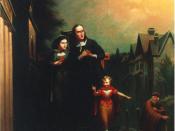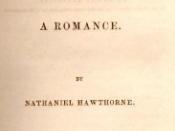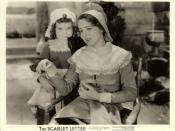The Scarlet Letter, by Nathaniel Hawthorne, is a book set in puritan times but written by a romantic author. These two contrasting styles are evident throughout the book and lead to a delicate intertwining of characters, ideals, and emotions. The novel revolves around a young woman named Hester Prynne who, after being abandoned by her husband, commits adultery, which is strictly forbidden in the puritan community, as it is one of God's commandments. For her sin, Hester is condemned to wear a scarlet A on her bosom for the rest of her life, thus forever separating her from the puritan community. Throughout The Scarlet Letter Hawthorne develops Hester Prynne as a strong, compassionate woman with nothing to hide.
Through her strong physical and mental state, Hester is able to overcome the abuses of an unmerciful society. The first demonstration of strength comes in her ability to stand on the pillory and be judged by each citizen as the magistrates seek to make an example of her and the sin which she and her child so vividly represent.
This punishment, although cruel by today's standards, is believed to be lax by many of her onlookers who would be pleased to see her hanged for breaking one of the Ten Commandments. Hester's "wondrous strength" is also noticed by several of the townspeople, in that she so dearly conceals the name of the person who understands and shares in her anguish (66). The citizens of the town hold various beliefs about her punishment, but all agreed that it takes a great deal of courage and character to stand in the public eye as a martyr, willing to take the blame for herself and her partner in sin. The strength and character of Hester is emphasized by the narrator when he creates a parallel between her and women such as the Virgin Mary and Ann Hutchinson. This parallel indicates a pure woman (in the Virgin Mary) and one with a strong sense of individuality (like Hutchinson). This pureness also indicates Hawthorne's belief that although Hester is a sinner at heart, she is pure and will be forgiven for her passionate sin. This belief is concurrent with those of the romantic era in which Hawthorne was writing. Because of her strength the scarlet letter that was meant to humiliate her, only makes her stronger as her vigor is constantly renewed by her undying love.
Hester, while capable of being strong, is also the first to show tenderness and compassion be it towards Dimmesdale, Pearl, or even the most spiteful of the townspeople. Hester's love and hope is most blatant through her willingness to accept the punishment for both herself and Dimmesdale, in hope that one day in whatever lifetime, they will be jointly forgiven. As he is dying, she asks him if it is possible that they will be together in their "immortal lives" (251). This question has a double meaning in that literally she wants to be with him, yet she is also trying to find out if all her loving and dreaming was in vain and, if not, should she continue to hope and be strong. Hester's compassion is also exemplified in her everyday actions as she is "so kind,"æ helpful,"æ [and] comforting" and donates all her spare time and resources to helping the less fortunate, but more critical people (159). It was this desire to serve the community above herself that (according to the narrator) changes the meaning of the scarlet A from adulterer to "able" (158). In taking care of Pearl, the child of her sin, Hester is constantly reminded of it and this further motivates her to serve those around her.
Hester is a woman who acknowledges her sin and therefore, doesn't try to hide it from the community. This becomes apparent almost immediately in her elaborate and detailed embroidery of the symbolic A that along with Pearl, represents her sin. The "gorgeous" A, made of fine silk and gold thread, stands a testament to her individuality and loudly proclaims that she will not conform (in her heart) to the punishment that society tries to push on her (51). It also indicates that she will wear it only to destroy its meaning and as a token of her love that will remain till her dying day. The other characters also thought the beautiful A to be unfitting on such a horrible person and are unable to see its true meaning and the work it does on Hester's heart. Hester understands what she did and why it was wrong, but rather than feeling sorry for herself, she boldly wears her token of shame knowing that her greatest punishment is Pearl and their inability to be together with the father. Hester realizes that her only hope for salvation and forgiveness is in the truth, and that her sin can be forgiven (while not in society, but in heaven) as it was a sin of passion and not intended to bring harm to other human beings.
In The Scarlet Letter Nathaniel Hawthorne created a character who would be alluded to for hundreds of years. Hester Prynne and her ignominious A stand for more than the sin of adultery, but rather are capable of teaching important moral lessons. Hawthorne's universal theme relates the importance of being open and honest about our wrongs and imperfections. Through this truth we can prevent battles within ourselves over how much of ourselves we are willing to let the world around us know. Hester also teaches us about desire and perseverance through her hope of forgiveness by God and the strength that this hope gives her. In this fashion, mankind is capable of beating whatever is thrown at us, and if the passion and desire is there, then we can each overcome our own scarlet letter.





